Complex, not always understandable to consumers product, high prices, over-the-top competition – it’s not easy to promote yourself in the market of IT-services even with big budgets. General marketers often do not understand the specifics of the niche and use traditional promotion models, which do not lead to the expected results. Clients spend huge sums, but do not get the desired effect.
Our new case is an example of complex marketing, which can help to promote the web-site of an IT-company without serious investments and to increase the traffic by several dozen times in a relatively short time.
How to advertise an IT company: an adapted marketing strategy for the IT niche
Client: a company, business area – IT services in the B2B segment, consulting.
Problems: no audience, the site does not convert applications, there is no clear marketing strategy.
The client began promoting himself back in 2015. He mainly attracted commercial traffic, tried to use internet marketing, but this had practically no effect on the number of customers and profits. The site was developing slowly, with no audience. Requests came, but they were very few. In total over two years the resource was visited by just over 30,000 users. In 2017 the client turned to us with the task of taking attendance to a higher level, increasing the number of hits and conversion rate.
Working, like our client, in information technology, we had a very different development experience. We implemented different mechanics and innovations, experimented and analyzed the results. Having spent from 100,000 to 150,000$ on testing various tools and combinations over several years, we developed our own strategy for promoting the company, thanks to which within a short time we increased the traffic on our blog on the topic of IT and marketing by almost 30 (!) times. Gradually the rest of the metrics grew as well: conversions, leads, and sales. This is the strategy we proposed to our client as well.

Market research
We started with global market research. Usually the first stage of SEO-optimization involves the collection of semantics, and competitors are analyzed on its basis. It is advisable when the topic is unfamiliar and it is necessary to collect the maximum number of key phrases. But the classic method has two drawbacks:
- Along with “juicy” keywords that show great interest in the topic, a lot of trash requests are collected, and it takes a lot of time to sift them out.
- The main thing is that such semantics does not give an objective picture. Collecting the semantic core, cleaning and clustering – a long process, and before the in-depth processing of semantics is impossible to predict whether there is real demand, whether it will bring commercial traffic.
Since we specialize in information technology and know the specifics of the niche from within, in working on this case we took a different path and went straight to the competitors:
- made a list of 100 major IT companies in the segment;
- made a selection of the tops by traffic in each sub-field;
- We studied the topics of the sites and determined the most popular headings suitable for our client;
- in each of the segments we selected materials that give high traffic, i.e. meet the requests that are really in demand in the market.
Content marketing and semantics for infotraffic
Based on the selected materials, we began to form a content plan – first by rubrics, then by future publications.
Because of the high competition, commercial traffic is very expensive for IT companies, you should not rely solely on advertising. We decided to put the main emphasis on informational traffic. It captures a wider audience, the competition is lower, and it is possible to work more effectively with it when certain mechanisms are introduced. Therefore, after the formation of a content plan for the sections, we returned to the stage of semantic analysis. For each story analyzed from 400 to 2,000 requests, of which were selected from 12 to 20 (sometimes more), then included in the texts.
The work is very time-consuming, but it fully justified itself – in the future it gave the customer a good share of traffic.
All content for the blog is divided into 3 main areas:
- Instructions, guides.
- General informative articles (+ supporting articles with queries from near-thematic environment to get search positions).
- Case packs.
Used mechanics of IT company promotion
We used a whole set of mechanics that have been tested on our project and repeatedly used in customer projects. The greatest efficiency comes from the integrated application of these methods.
How to promote an IT company in Google with additional in-depth research
A deep dive into the subject provides an advantage in marketing strategies. The methodology varies depending on the tasks at hand, but never without gathering primary information.
Selecting prospective inquiries
The goals of in-depth research can be different. For example, they can be used to assess the prospectivity of search queries – how well they sell. Once we needed to process about 650 customer enquiries for 20+ sites. As a result, we isolated the strict body of the search query and identified its main tails. Based on this sample, we compiled an SEO matrix:
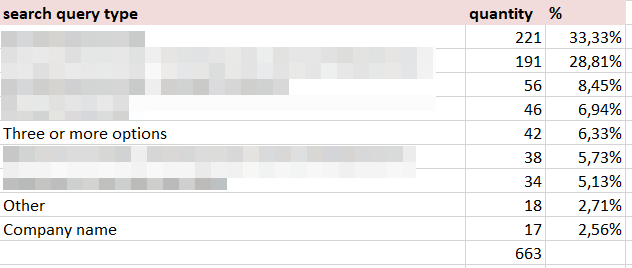
The output data clearly demonstrates the effectiveness of search queries: key phrases containing 3 or more monitored parameters are found among requests in 5-7% of cases, and the name of the company – only in 2-3%. The research was conducted for a non-branded product – the ratio will be different for popular brands.
The number of words in effective requests can be estimated in a similar way:
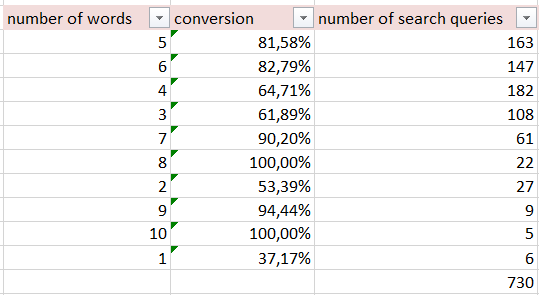
We applied the same mechanics in this case. The in-depth research done for the client gave us a clear idea of which queries are worth working with, optimizing advertisements and web pages for them, and which should be excluded, as they will not be useful.
Expert Materials
Another example of in-depth research is the preparation of expert publications. It was decided to place expert materials on four of the most demanded areas in the IT niche on the client’s blog. For example, one of the studies was devoted to IP-telephony.
To make the content useful for visitors and bring more traffic, we had to dive deep into each of the topics. To do this, we:
- gathered information on the top vendors, services, and products relevant to the chosen topic;
- interviewed the managers of all the selected companies under the guise of a client/partner;
- made an analysis of the data obtained.
Interview questionnaires included 20-30 questions each, sorted according to the same number of parameters. The lists included from 50 to 200 objects under study. Between 60 and 100 hours were spent to prepare each of the materials.
Creating an expert article is a painstaking, complicated, labor-intensive and expensive job. Therefore, such materials were few, but they gave a very good result.
- According to text factors, the pages of the site took a stable position in Google:
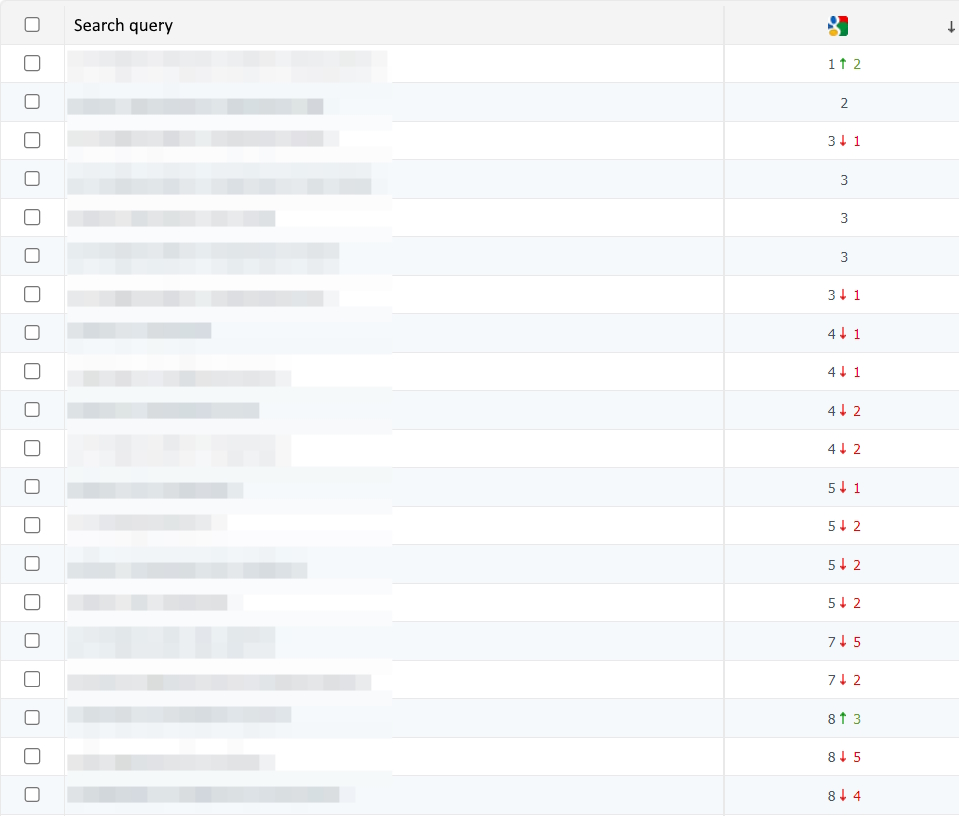
- Our client began to be approached by companies – leaders of the niche to which the article was devoted, with a request for placement.
The publication of expert material is beneficial in the long term, because it gradually leads to an increase in traffic and conversion. However, it should be understood that the effect will not be endless, and the material will have to be updated regularly.
Link building
The next step was to run the site through various content islands. We placed the site on about 100 sites in stages:
- in Internet directories;
- on industry and news portals;
- forums;
- question and answer services.
In addition to the classic “gentlemen’s kit,” we used a number of unobvious link building techniques, from posting in blog comments to getting backlinks from Web resources for charitable foundations.
Link building is one of those things that can give you good link building. Requires a lot of resources to implement, but allows you to reach high positions. Soon, for many niche queries, we brought the client’s blog to the top of the search. In particular, the query “system integrator” overtook even the sites of companies with a billion-dollar turnover.
The problems of free links:
- Low survival rate: 5-10% at an interval of six months to a year. Part of the links will not be placed or will be removed by administrators, the other will not be indexed. Some sites and do not exist – according to statistics, after three years of 300 free donors remain about 100.
- Most donor sites initially does not pass the test on the simplest SEO-metrics. In practice, out of the entire sample of only about 1% (!) donors will meet the requirements, place a link and will survive at least a year and a half.
Free links are not ideal, and their freebies are conditional. The cost of placing each such link, taking into account the manager’s time to obtain it, is on average 30$.
To make link building more productive, the practice of distributing backlinks through various exchanges is widely used in Internet. Google has a very negative attitude to artificial link building, so in the US and Europe began to fight such services back in the mid-2000s.
SEO links are perfectly indexed, but search engines often exclude them from ranking. For example, Google filters up to 98% of such links.
We offered the client to post 150 links 150-200 links, increasing the link base gradually, over a year or two, at a rate of 10-20 links per month.
Here is what systematic link building looks like:

Free links are not ideal, and their freebies are conditional. The cost of placing each such link, taking into account the manager’s time to obtain it, is on average 30$.
How to promote an IT company with outreach
Outreach – the direction of crowdfunding, which involves the promotion of a web resource by placing backlinks by personal agreement with bloggers and site owners. The method allows to improve organic ranking, expand the audience, build user trust, increase brand awareness.
The methodology is very resource-intensive, both in terms of communication (even with developed negotiation skills, no more than 3-4% of recipients respond) and in terms of preparing content to be posted on third-party sites.
Is it worth it? In principle, yes. The advantage of the method is that the site begins to refer to really authoritative thematic sites with high attendance. Potentially, these links can bring and direct targeted traffic.
Costs outreach is not cheap, primarily because it involves very high quality content. Therefore, to prepare and place no more than 3-5 pieces per month, and even this small amount takes all the time specialist outreach. The cost of an expert article comes to 300-400$ (for 2022), and this is not the limit.
The fee for placement on the site varies. Sometimes it is possible to post for free, but this is more of an exception. Depending on the authority and attendance of the resource, one link is priced between 10 and 15,000$.
Thanks to integrated link building we have managed to increase the link weight of the client’s site and get additional targeted traffic. Since getting backlinks is one of the processes that should not stop, work in this direction continues.
LSI Copywriting
In addition to expert and classic SEO-optimized materials, prepared for the blog of the IT-company articles created using LSI-copywriting.
LSI-copywriting (from latent semantic indexing) – technology of text optimization, when in the forefront not the accuracy of key queries, and the words and phrases closest to the subject of the article.
In texts based on LSI principles, many obvious and non-obvious relationships are created, which helps the search engine to better understand the content, match it to the search query and select the most relevant pages. The main task of the optimizer is not to saturate the content with semantics, but to create a text that maximally reveals the stated topic.
Evergreen Content
When talking about attracting traffic and increasing a web resource’s ranking in search engines, you can’t forget about such a content marketing method as creating evergreen content.
Evergreen content – materials that do not lose relevance over time (or lose it insignificantly). In the topic under consideration, such materials would include, for example, articles for the queries: “how to promote an IT-company”, “examples of promotion in social networks”, “internet marketing for an IT-project”, “case of promotion of an IT-company”, etc..
In the customer’s niche, these are various instructions, manuals, analytical articles, cases, etc. It was mentioned above that this is the kind of material we included in the content strategy.
Placing “long-form” content is beneficial for at least two reasons:
- it eliminates bursts of activity – attendance does not depend on new publications and stays within the same range;
- behavioral factors improve, natural link mass grows – evergreen articles are read, commented on, shared links to them in social networks and other resources.
Technical optimization
Monitor the loading speed, the serviceability of modules, the absence of dead links and unnecessary redirects, and other parameters of the site should be constantly. Technical optimization is needed not only to reach certain positions in search, but also to stay on them.
In terms of technical optimization, the client site was not configured quite correctly and required modifications. Having worked hard on it at the end of 2017, in January-February 2018 we already had a significant increase in traffic, breaking the bar of 1,000 visitors weekly.

In itself, technical optimization does not give strong growth, but it increases productivity, speed, other important indicators, and becomes a kind of admission ticket to the top 10 search engines.
The minimum score for desktop devices, which we were aiming for earlier, was 70, for mobile devices it was 40. Now we have to make sure that we always stay in the green or yellow zone:
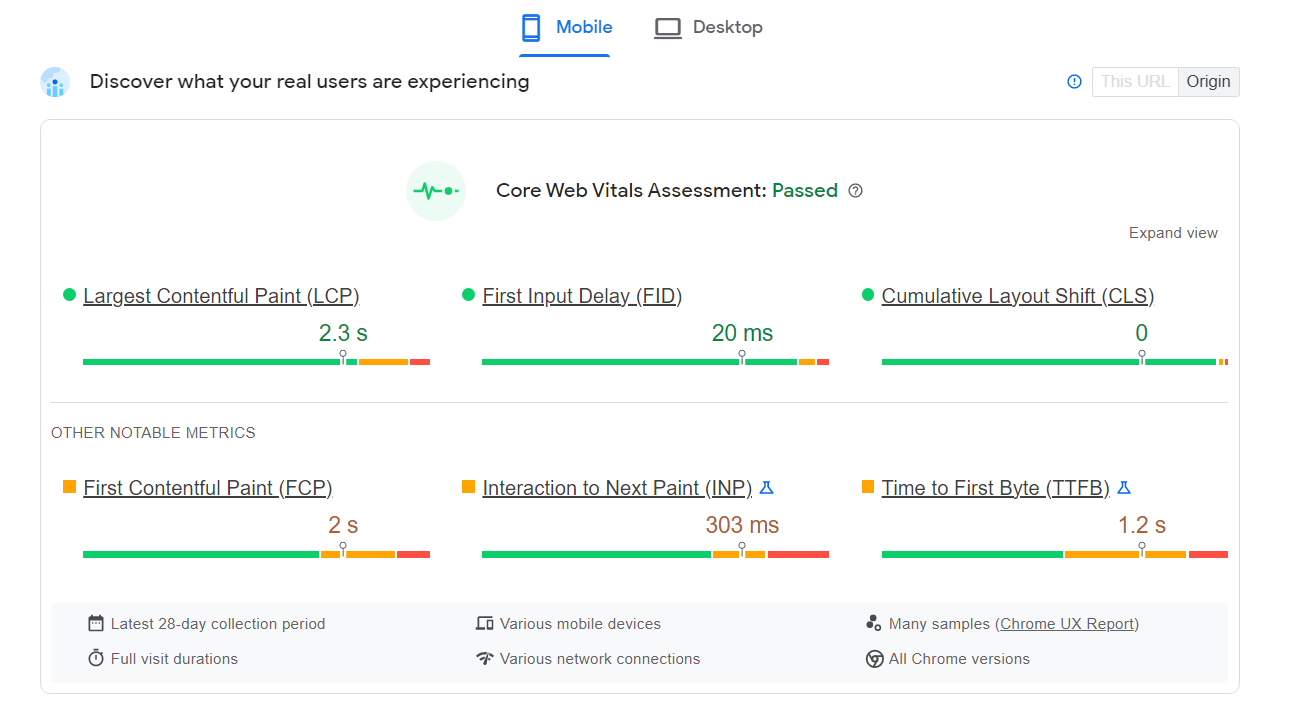
In a highly competitive environment, being in the green zone creates a small advantage, and if a site is already represented in the top 10, for example, page load speed does not play a big role. In general, it is necessary to focus on the mobile index, which Google pays special attention to.
Another important indicator of the quality of technical optimization – the safety of the site for visitors. Its direct impact on ranking is insignificant (in the extreme case a resource in the top 10 will be marked as potentially dangerous), but it has an indirect impact on business in general.
We used standard tools – Google Search Console and regular hosting tools – to evaluate the security of an IT provider’s site:

We checked the quality of both desktop and mobile versions of the site:

Technical optimization tools also include indexing settings:
- robots.txt – file, which specifies the basic parameters according to which the site should be indexed by search bots;
- meta tags robots – special code that allows page-level control of indexing settings and display in search results;
- Last Modified Since, a vital parameter for online stores, portals and other large online projects;
- sitemap.xml – Site map, which gives the search engine the actual structure of the web resource and helps navigate among the many folders and files.
Ignoring the issues of indexing management can bring unpleasant surprises as early as 2-3 months after the start of work.
How to promote an IT company in social networks: a set of retargeting base
As soon as the active process of working on the case began, we put social media pixels (Facebook, LinkedIn, Youtube) on the IT company’s website. Over time, this helped us gain a large base for retargeting advertising campaigns and working with potential clients. Today the audience of each of the bases is from 100,000 to 150,000, which makes it much easier to promote.
The segments we did on the basis of retargeting turned out to be around 200. We identified 30 main ones, connected them to the quizzes and the landing pages and set up Facebook and Google Ads to these bundles.
Overflow audiences from the retargeting base to a specific offer – one of the simple mechanics that we use both ourselves and in client projects. It works as follows:
- Select users who read the blog materials with high engagement, but for some reason did not leave a request.
- We switch this audience to a specific offer and close for a consultation or just show branded ads for coverage.
By the way, simple advertising on the coverage of the brand had a very interesting effect: our client began to approach the old partners and clients to whom the company had already provided services.
Behavioral factors
A very important part of the work. Analyzing behavioral factors (PF) is necessary all the time. For this purpose we used special analytical tools, in particular Google Analytics.
On its own, analytics is not particularly interesting – what matters is the conclusions it leads to. For example, when choosing a targeting strategy, gender, age, and audience interests matter.
Examples of work with analytics
The chart below shows that the highest rejection rate is for audiences under 24 and the lowest for those over 35.
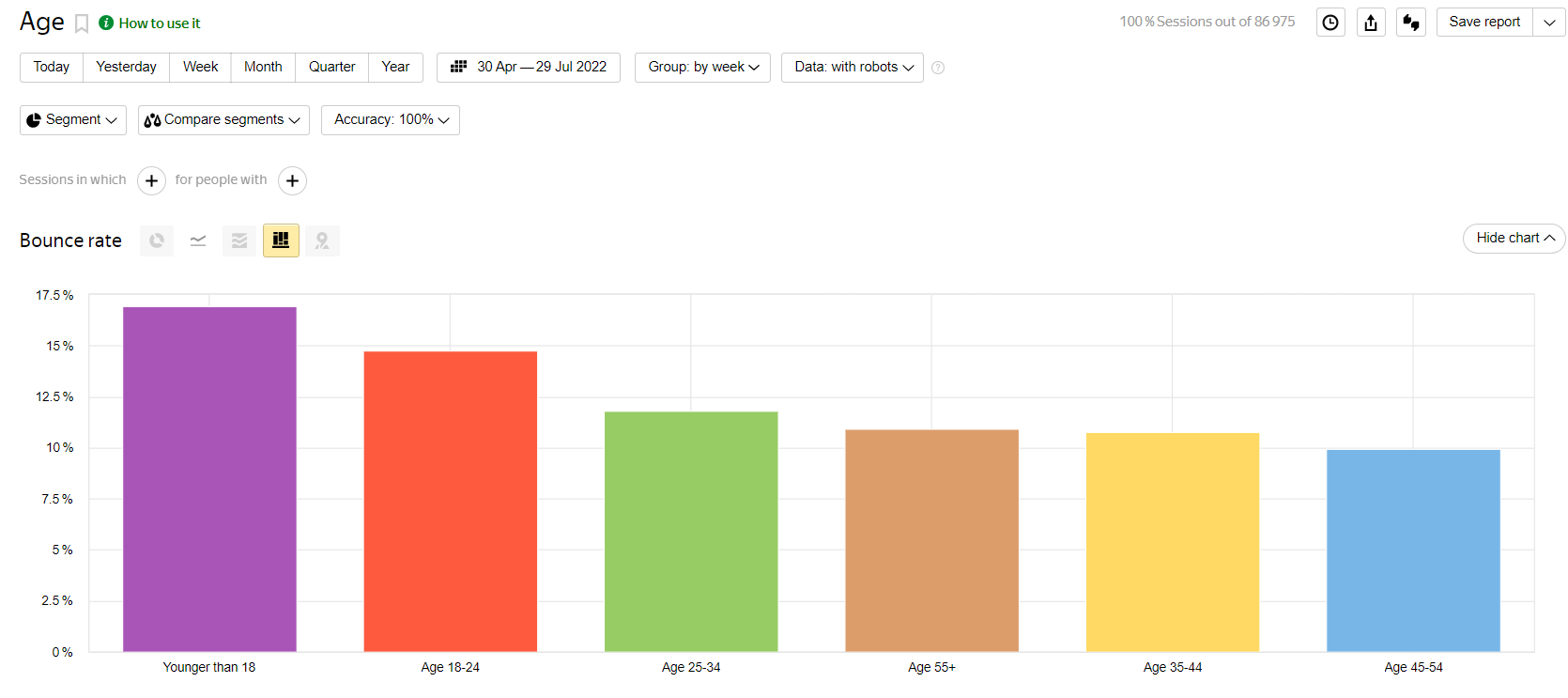
The second graph shows that about 25% of visitors are young people under 24 years old.
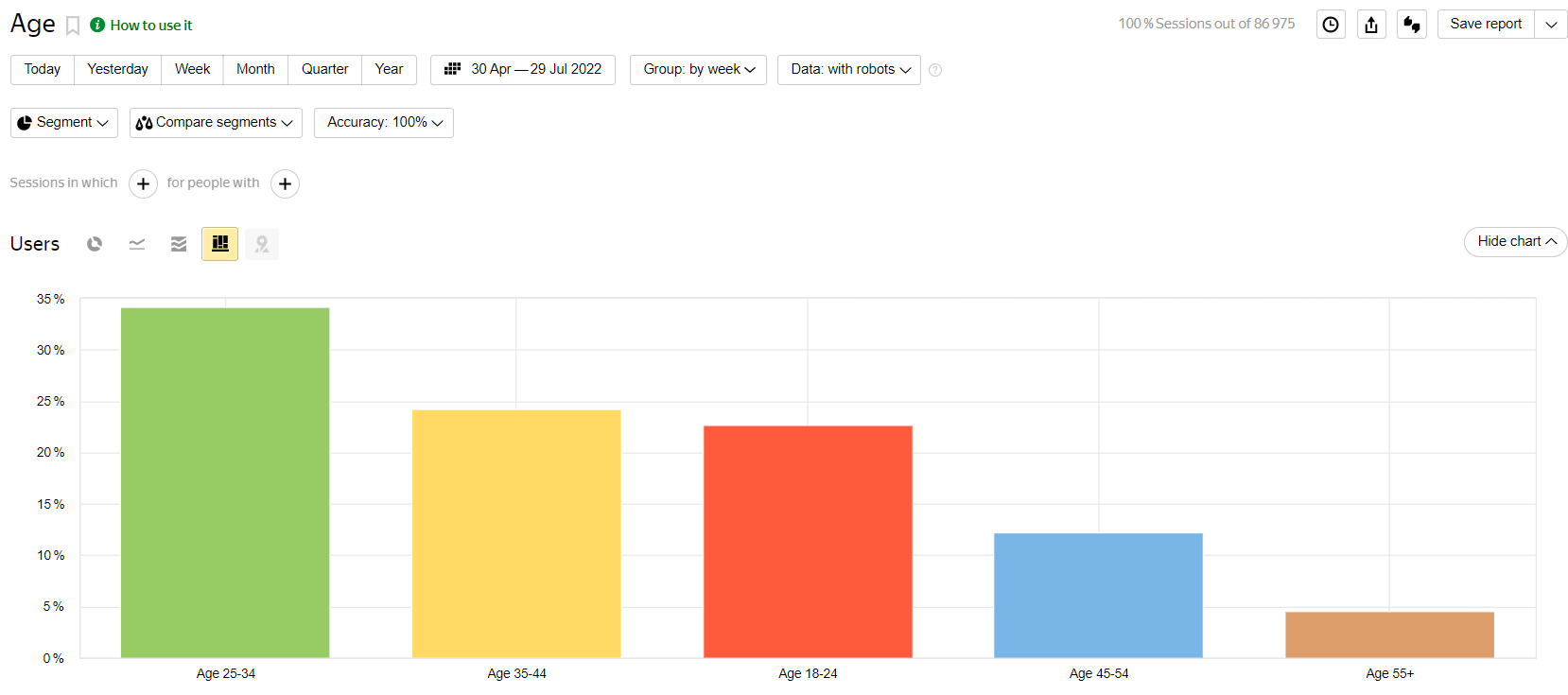
How can this be interpreted? Despite the fact that the client’s blog is focused on IT services, there are also students, that is, non-targeted requests. So, when creating a content plan for future publications, we need to take this into account. If the audience consisted of young people under 24 years old by 50%, and refusals rose above 25%, we should change the content completely.
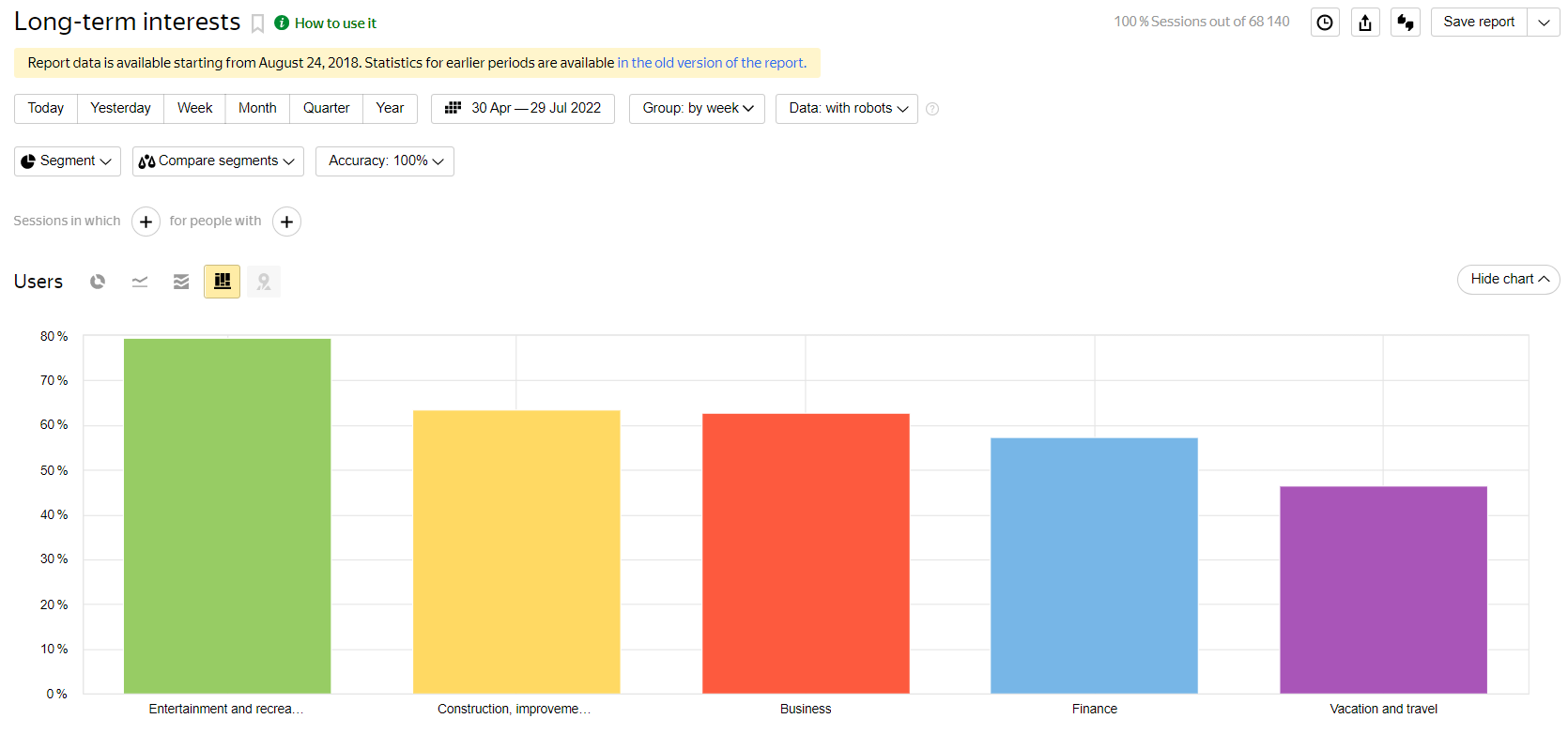
Another example. The graph above shows that 80% of the audience is interested in the topic of entertainment, about 64% in repair, and 46% in recreation and tourism. The obvious conclusion to draw is that we are working with the wrong audience. In fact, these are “universal” topics that almost all Internet users are interested in. Therefore they are not informative and we can safely discard them.
What other information you can get from analytics
From the data of analytics can also learn where users come to the site – the main entry points. This information helps us identify key traffic pages. And to find out how users behave on specific pages, we use granularity and look at metrics such as time on page, refusals, depth of view. We evaluate the most interesting pages at the webview level.
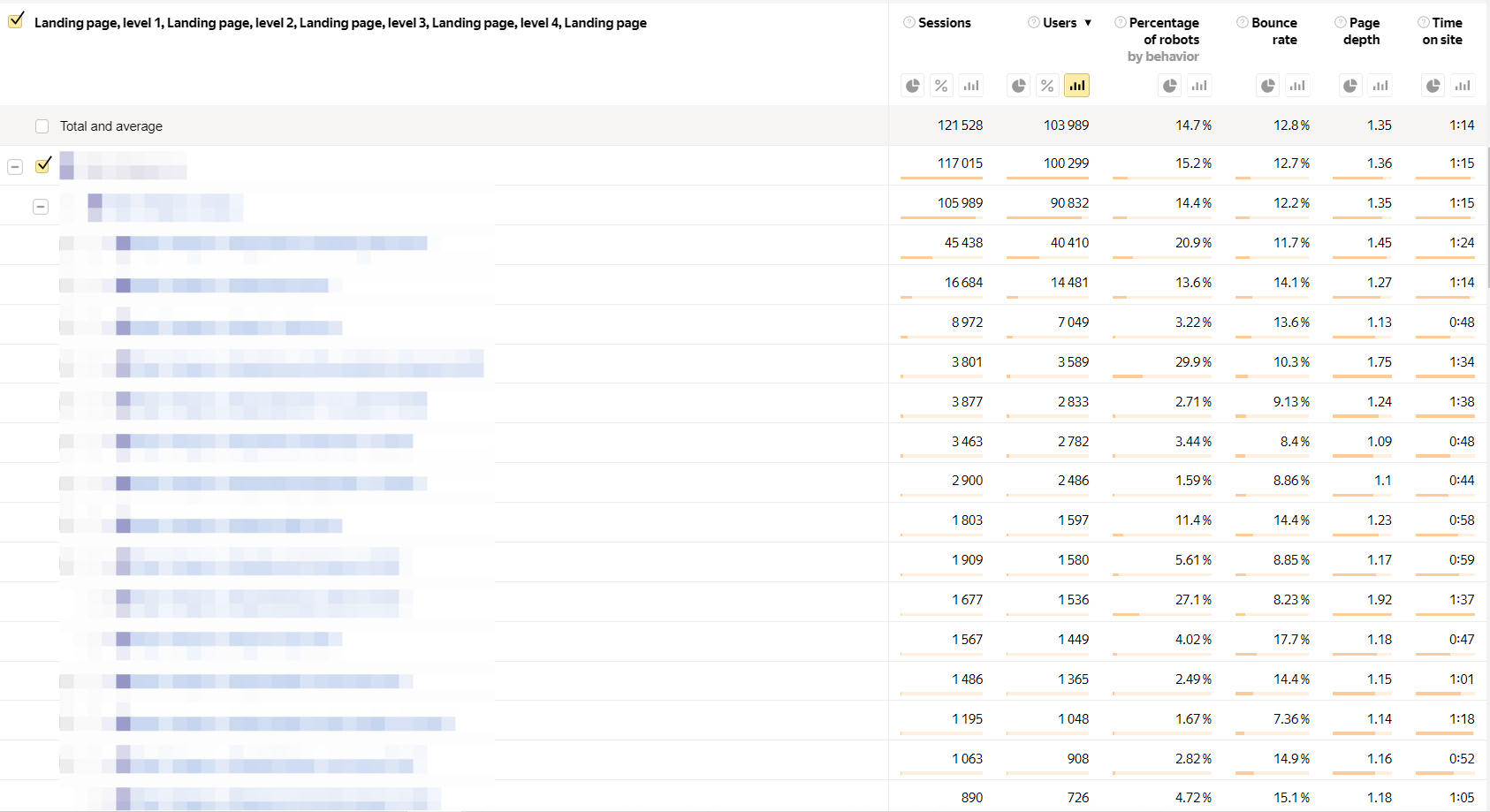
Based on the analysis, we draw conclusions and make appropriate adjustments to the site. The options for adjustments will vary depending on the indicators:
- On pages where the bounce rate is slightly better than the site as a whole, and other metrics are in the normal range, you may need to increase the amount of content and add internal links to other sections;
- low metrics will require a complete redesign of the content.
Analytical tools allow you to sample the right metrics and get a list of pages whose refinement will potentially improve internal PF.
Search engines actively monitor user behavior. Improving PF reduces the percentage of returns to the search engine for query refinement, which has a positive effect on ranking.
Bindings
The mechanics used on the site of an IT company helped to increase traffic several times over. It remained to convert it competently. We decided to include tried-and-true bundles that had shown themselves well in our project:
retargeting-base + quiz-marketing + consulting weblinks
It was necessary to adapt them to the customer and determine the segments that brought the most profitable bids. We took measurements, did mass retargeting, segmentation, ran ads, and started pouring traffic from different networks into these bundles. We looked at the cost of each application for each segment. We were guided by volumes: if there were no requests at all, and everything was fine with the technical settings and the offer, we turned off such segments. As a result, out of the 30 segments we selected the two most profitable in terms of cost per bid.
Subscription base
Automated the collection of contacts for the email and Telegram databases. We enabled retargeting, made subscription pages. Email-base increases by about 30 new subscribers every month, Telegram collects from 10 to 20. All this on a full automatic basis and with zero investments.
Now we are finalizing the mechanics, in particular, we are going to add targeting to Telegram, which should increase the speed of recruiting a subscriber base by 20-30%.
Chat automation
When there is a lot of traffic, we always recommend that customers connect automation. As numerous tests have shown, it works for all major languages and gives good results in any niche.
For this case we set up automatic invitations in the online consultant. We divided the audience into segments. All the materials on the client’s site (about 500-600 at the time) were divided by themes and pages and combined into categories. For each category we created a simple open-ended question which helped to qualify the users. Such questions we got about 80.
They were the first to write – if the bot noticed that the person was on the page for more than 60 seconds, that is, he had a clear interest in the material, it was sent to the chat room with the question prepared in advance for a particular audience. Depending on the answer, we arrange a personal meeting, invite them to Zoom, or pass the request for processing in the standard mode.
Auto invitations simplify the process of qualifying requests, cut off unpromising ones and give an understanding of how to further work with potential customers. In addition, they convert well and bring sales.
We use auto-advice on many customers’ online sites, and sometimes it leads to big deals with top service consumers.
Site customization
Another mandatory component of setting up a web resource. The number of incoming calls largely depends on how the company initially positions itself on the market. For example, if the site only lists a local telephone number, you should not expect high traffic and clients from other regions.
This is why we technically configured the site to receive traffic from different regions: we made appropriate optimizations, recommended buying a set of regional numbers, included geo parameters, registered in the required directories, enabled functionality for contact substitution, etc. This gave a big increase in traffic.
When setting up site personalization, a simple rule applies: where the demand zone – those regional numbers and should be used.
When it comes to foreign segments, we always advise you to buy the phone numbers of the country whose language the multi-lingual site is translated into and put them in your contacts. This gives very cool results.
Integrations
We set up a set of integrations to automate part of the processes and the company could manage with a small number of managers:
- Call-tracking;
- CRM;
- WhatsApp and Telegram (with the ability to write first).
Thanks to integrations, all requests received by email, online chat, and messengers are collected directly in the CRM. Now potential clients are not lost, and one specialist can handle up to 10-15 complex requests every day.
In the segment of B2C and more simple compared with information technology topics with properly configured integrations manager can handle the volume of up to 200 (and sometimes up to 500) appeals per day.
Integrations not only pull in data from various services and allow for one-stop communication, but also give you the opportunity to be the first to write on WhatsApp and Telegram. And such functionality greatly simplifies interaction with potential clients.
We also implemented multi-channel analytics on the client’s site and enabled dynamic email tracking, which substitutes email addresses depending on the source of the click.

Results
Over the course of the project, we have raised traffic by about 45 times. While 32,000 visitors came to the site in 2015-2017 (2-year statistics), by 2020 we managed to reach 30,000-50,000 visits per month.
And by the end of 2020, traffic had grown to 50,000-60,000 monthly visitors.

We have also gathered an extensive retargeting base (about 350,000 people in total), which can then be repeatedly monetized.
The number of requests from the site increased by 1000%, conversion to sales – by 32%.
Since 2016 we have been working in information technology and digital marketing. Understanding the specifics of the niche helps us to achieve better results when promoting IT companies compared to marketing agencies with no experience in this field.
